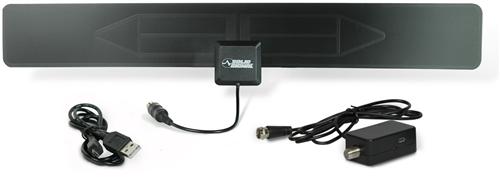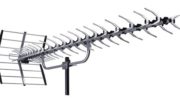It’s a question many people ask. Sometimes it’s because they can’t get up on the roof to add an antenna. Sometimes they just think big antennas are ugly. No matter what the reason for asking, there’s a simple answer:
Maybe not as good, but maybe good enough.
It’s a well-known fact that you lose at least half your signal when you bring an antenna indoors. You could lose more depending on the construction of your home. Yet fewer and fewer of us want to go up on the roof. Whether it’s a TV antenna, cellular booster or something else, we just want to put it inside. And, of course, we want it to be small. The 11-foot-long HD8200XL antenna doesn’t look really good in a living room.
On average, an indoor antenna installation will pull in signals only about 15% as well as a large outdoor antenna installation. Yet, that may be enough, believe it or not. Digital signals aren’t terribly dependent on strength; what’s more important is whether it’s possible to detect the signal in the surrounding noise. Raw power isn’t a big part of the equation. A more powerful antenna will definitely give more signal without giving more noise, but if you have enough signal from a small antenna, even on a stormy day, having more signal isn’t going to do anything for you. Your HD picture won’t get even clearer, your phone isn’t going to have even better service. Digital signals are more of an “it works or it doesn’t” proposition.
It’s 2022, so…
Because practically no one has to worry about analog signals from a phone or TV antenna anymore, antennas have shrunk to the point where they can still do well and not be huge. That means you actually do have the ability to move the antenna indoors and have it work in some cases.
In the case of cell boosters, we’re starting to see some really excellent products from weBoost and SureCall that work astoundingly well with very small antennas. Yes you do have to mount them as high up as possible, but in the case of an apartment it’s still possible to mount the outdoor antennas on a railing. They do so because of the new crop of extremely low noise amplifiers out there. When you amplify a signal, you always add noise, and in the past that’s been a problem since the noise could actually overwhelm a weak signal, and adding noise to a marginal signal could actually make it worse. These new amplifiers add as little noise as possible while pumping up the signal, making indoor amplifiers quite effective. The same technology when applied to a TV antenna helps a small antenna act like a big one, too. While amplified TV antennas aren’t usually the answer — if you need a big antenna that’s what you need — at least these amplified antennas are not hurting and could actually help in some cases.
Yeah, but what about satellite?
You’ll notice I haven’t talked much about satellite. Satellite signals are so weak that it’s basically impossible to bring the antenna indoors, and dishes just aren’t going to get smaller without some really serious changes in technology. They already have super-low-noise amplifiers so that isn’t going to help either. Besides, satellite dishes take extremely careful aiming so it’s really better that they are outside of the reach of careless hands.
I still recommend using large antennas, placed as high up as possible, for both TV antenna and cellular use. However, not everyone can get up on the roof and the good news is that more and more, you don’t have to.
Get the story from Solid Signal
You can get all the accessories you need when you shop at Solid Signal. It’s your source for the antennas you need for practically anything you have. If you need help choosing an antenna, call us! We’re here during East Coast business hours. The number is 888-233-7563. If it’s after hours, fill out the form below. We’ll get back to you, usually within one business day.





